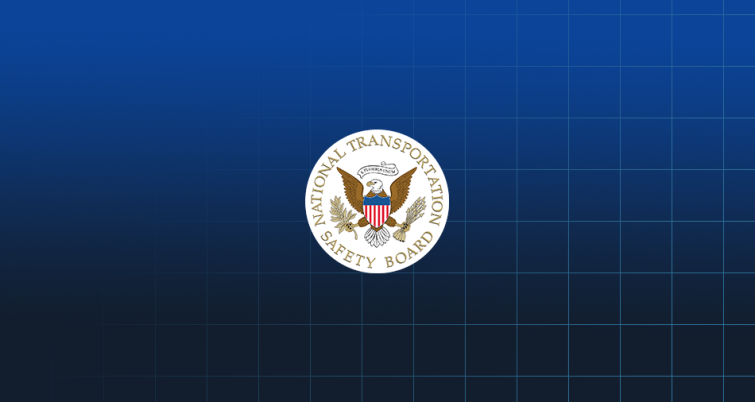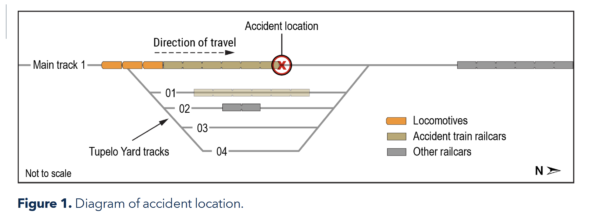NTSB releases final report on KCS conductor fatality
Written by David C. Lester, Editor-in-Chief
The National Transportation Safety Board has released its final report on the death of a KCS conductor on December 23, 2020.
Below is an excerpt from the report. If you wish to read the final report, please follow this link.
1.1 Accident Description
On December 23, 2020, about 6:55 a.m. local time, the conductor of Kansas City Southern Railway Company (KCS) train L-CO302-22 was struck and fatally injured by the train in the Tupelo Rail Yard in Tupelo, Mississippi. (1) The accident occurred on main track 1 at milepost 278.0 on KCS’s Artesia Subdivision. (See figure 1.) At the time of the accident, the train consisted of 3 locomotives and 22 railcars. It was dawn, the sky was clear, and the temperature was 44°F with light winds from the south.

The crew, which consisted of an engineer and a conductor, operated their train from yard track 2 to yard track 1 to pick up 22 stored railcars. After picking up the 22 railcars, the conductor climbed onto the northeast corner of the lead railcar to direct the train movement. Using his portable radio, he then directed the engineer to shove the train north along main track 1 the length of 40 railcars to couple with additional railcars.(2) After moving the train about 15 railcar lengths, the locomotive engineer, who had not received additional instructions from the conductor, applied the independent brake to reduce the train’s speed and prepare to stop in accordance with the General Code of Operating Rule (GCOR) on radio contact. (3) Event recorder data showed that the engineer maintained an average speed between 9 and 10 mph before braking. As the train began to slow, the conductor reported that the train was 10 railcar lengths from coupling to the nearest railcar. In his interview with NTSB investigators, the engineer said that the distance reported by the conductor was shorter than the engineer had expected given how far the train had traveled. The engineer said he increased the locomotive independent brake rate, and the train’s speed then decreased from 9 mph to 6 mph in about 3 seconds.
During independent braking, energy from the locomotive’s deceleration is transmitted down the train through the mechanical couplers, an effect called slack action. (4) Because there is slack (a small separation) between each railcar coupler, there is a delay between each railcar as it begins slowing and when it stops. When the energy pulse reaches the last railcar, the rest of the train has already decelerated over a distance proportional to the total amount of slack in the train. This transmitted energy, or slack action, often results in a sudden energy pulse.
As the engineer prepared the train to couple to the stationary cars, a KCS employee working in the area heard a commotion over the conductor’s radio. Both the KCS employee and engineer then heard distorted communication followed by the conductor communicating over his radio that he’d been injured. By the end of the communication, the engineer had stopped the train. The KCS employee called 911.
Tupelo Fire Department responders arrived on-scene within 10 minutes and transported the conductor to North Mississippi Medical Center, where he died from his injuries.
_______________________________________________________________________________________
1 (a) Visit ntsb.gov to find additional information in the public docket for this NTSB investigation (case number RRD21LR006). Use the CAROL Query to search safety recommendations and investigations. (b) All times in this report are local time unless otherwise noted.
2 (a) Shoving is the process of pushing railcars or a train from the rear. (b) Railroad personnel commonly use railcar lengths to communicate distances during switching operations.
3 (a) The independent brake is a manually operated brake in the locomotive used to apply and release locomotive brakes independently of train brakes, which apply braking force to each car simultaneously. (b) Under General Code of Operating Rule (GCOR) 5.3.7, radio communications for shoving movements must specify the direction and distance of the movement. In the absence of further communication, movements must cease within half the distance specified in the last communication. See “5.3.7 Radio Response” in General Code of Operating Rules, 8th ed., April 1, 2020.
4 (a) Slack action is the free movement of a railcar before it transmits motion and energy to an adjoiningcoupled car. (b) Train makeup and operational circumstances can preclude minimizing slack action by applying the brakes on each car.





